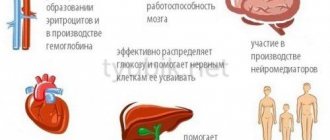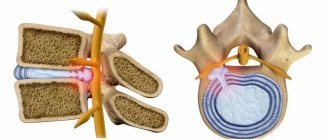The human body is a very complex mechanism. Unlike cars or electrical appliances, its power cannot be limited to one specific product. A huge number of different organs, tissues, systems and functions require the use of almost all known, with the exception of radioactive, elements of the periodic table.
This article will analyze in detail the table of vitamins in foods, their role in life, daily requirements and signs of deficiency.
What are vitamins
These are simple compounds whose molecular formula is quite simple. But despite this, they are vital for the functioning of organic life. They can either come from the food you eat or be synthesized directly in the body.
Vitamin D from the table can only be formed under the influence of solar energy, therefore it is considered solar and irreplaceable.
These small compounds control metabolic processes in the body. The lack of even one of them can disrupt the complex operation of all systems. This can lead to complex diseases in a chain reaction.
Therefore, you need to try to establish the supply of each of them by creating the right diet.
Deficiency and excess
Deficiency and excess of vitamins in the human body can lead to disruptions in the functioning of systems and organs, provoke exacerbation of chronic diseases and cause premature death. Symptoms characteristic of a deficiency or excess of vitamins in the human body are given in the table below.
| Vitamin | Hypervitaminosis (surplus, excess) | Hypovitaminosis (vitaminosis, deficiency, deficiency) |
| A (retinol equivalent, retinol, carotene) | Severe pain in joints and soft tissues, liver problems, red eyes. | Decreased vision, skin problems, digestive disorders. |
| B1 (thiamine) | Loss of energy, memory loss, nausea and loose stools. | Plaques and blockage of blood vessels, excess weight, swelling of the limbs. |
| B2 (riboflavin) | Rash on the mucous membrane, photophobia, loose stools with foul-smelling discharge. | Hair falls out, nails peel, skin dries out. |
| B3 (PP, nicotinic acid, nicotinamide, niacin equivalent) | Digestive problems, lack of appetite and vomiting after eating. | Fatigue in the morning after a long sleep, surges in blood pressure. |
| B4 (choline) | Depression, tearfulness, drooling, stomach pain. | Migraine, tinnitus, dizziness, motion sickness. |
| B5 (pantothenic acid, calcium pantothenate) | Restless sleep, fear and excitability. | Early toxicosis of pregnant women, muscle weakness, lack of appetite. |
| B6 (pyridoxine) | Tingling in the limbs, numbness of the fingers, numbness of the skin. | Memory deterioration, reluctance to learn, difficulty in perceiving information. |
| B7 (biotin H, histine) | Hyperactivity leading to exhaustion, mental agitation. | Weakness, problems with movement. |
| B9 (folic acid) | Causes hormonal changes in the female body, provokes convulsions. | There is a high risk of miscarriage and malformation of the embryo. |
| B11 (levocarnitine, BT) | Sleep problems, fear and eating disorders. | Poor digestion of food, loose stools, fatty stools, weight gain (mainly in the form of fat deposits). |
| B12 (cyanocobalamin, cobalamin) | Skin rashes, mouth ulcers, tachycardia. | Loss of energy, bad mood and depression. |
| B13 (orotic acid) | Dermatitis and toxicosis. | Kidney failure, chronic fatigue. |
| B17 | It has a toxic effect, since during the breakdown of excess substances, hydrocyanic acid is formed. | Neoplasms, including oncological ones. |
| C (ascorbic acid) | Nausea and dizziness, fatigue and slow reactions, depression, stomach pain with the urge to vomit. | Decreased level of resistance to colds (decrease in general immunity), scurvy. |
| D (calciferol) | Hardening of ligaments and cartilage, hemorrhages under the skin, thirst, feeling of heat. In children it can cause enuresis and abnormal growth. | Bones break, rickets and osteoporosis occur. Fractures heal slowly because calcium cannot be absorbed without the vitamin. |
| E (tocopherol) | Headache, weakness, double vision. | Feeling tired, poor wound healing, dry skin. |
| F | Excess weight, rash, tissue bleeding. | Skin problems, early wrinkles, disruption of the heart muscle. |
| K (phylloquinone) | Anemia, hypoxia, insufficient tissue nutrition, dizziness. | Menstrual irregularities, problems with hematopoiesis. |
| N (lipoic acid) | Skin rashes, abdominal pain. | Excess weight, poor circulation and lipid metabolism. |
| U (S-methylmethionine sulfonium chloride) | No reliable data. | Stomach diseases, obesity. |
Both excess and deficiency of vitamins are harmful to humans, although most often it is insufficient intake or low production of one’s own vitamins that is a prerequisite for serious disruptions in the body’s functioning.
Absorption of almost all vitamins occurs in the intestines. This organ is responsible for the amount of useful substances in the body, because it can regulate many of them. The balance of vitamins in the body is also influenced by the compatibility of vitamins and minerals. Scientists have been able to prove that many substances work for the benefit only in conjunction with calcium or iron, and also have antagonists. If certain substances are absent or present in minimal quantities in the body for a long time, the system fails: the general condition is disrupted and the body becomes more susceptible to viruses and bacteria.
In this section I would like to say that all the information given above is general and is of a recommendatory nature. If you notice any of the listed symptoms, you should not immediately inject or take medications internally.
In order to make sure that it is hypovitaminosis that is the cause of the manifestation of a particular disease, it is necessary to carry out a biochemical laboratory test of blood and other body fluids. To do this, first of all you should consult a doctor. The full complex can be provided by most laboratories at clinics.
Water-soluble vitamins
Similar to the previous heading, these are compounds that dissolve in water. They have some features that need to be taken into account when consuming them. For example, they cannot tolerate high temperatures, which is why hot tea with lemon is not as healthy as everyone thinks it is. Table of water-soluble vitamins: B, C.
There are compounds similar to vitamins. They are called differently: antioxidants, microelements, etc. Doctors and scientists include them in the table of vitamins that a person needs because of the properties they have on the body.
Functions
The vitamin content table is an indispensable tool for anyone who wants to directly improve the quality of their life.
Each of them must be present in a person’s diet, of course, with the exception of cases of allergies.
They all interact with different enzymes and perform vital functions.
Vitamin A
In professional circles it is called retinol. Participates in the functioning of the visual system and promotes the regeneration of intraocular rods and the retina. Needed for the healthy functioning of small muscles responsible for shell deformation.
In addition, without it, the process of formation of connective tissue is difficult or almost impossible. Necessary for growing organisms for growth, healthy skin and oak trees.
Contained in food of both animal and plant origin.
Its predominant amount is found in:
- Livers of fish and cows;
- Eggs;
- Dairy products;
- Pumpkin;
- Bell pepper;
- Carrots.
A distinctive feature of fruits and vegetables with vitamin A is their red color.
In rare cases, it is replaced by beta keratin, which is also beneficial and is a product for creating retinol.
What products does it contain?
Now it’s worth considering the most important point - where vitamin K is found. Generally speaking, it is found in the following foods:
- Vegetable and animal oils . It is no secret that a certain amount of menadione is contained in butter. In addition, the structure of the element belongs to the category of fat-soluble, so fats must be present in the diet.
- Juices . Drinking freshly squeezed juices is of great benefit. However, the canned version is not suitable - there is no beneficial component in such drinks.
- Nuts . Here you can highlight the walnut.
- Vegetables . These “guests” of the table are considered the main suppliers of an important element. So, the diet should contain a lot of cabbage, spinach, lettuce, broccoli and others - they contain up to 400-500 mcg of menadione per 100 grams.
- Dairy . If we consider this category, it is worth highlighting only two representatives - goat milk and cheese. As for classic (cow's) milk, it contains almost no substance in question.
- Fruits and dried fruits . These elements of the diet also do not boast a high content of menadione. It is worth highlighting only prunes and plums.
To accurately see the vitamin K content, the following list of foods (per 100 g) will be useful:
- spinach - 480 mcg;
- broccoli - 220 mcg;
- soybean oil - 184 mcg;
- olive oil - 165 mcg;
- cod liver - 100 mcg;
- cauliflower - 60 mcg;
- beans - 45 mcg;
- cucumbers and green peas - 30 mcg;
- veal - 30 mcg;
- strawberries - 12 mcg.
Vitamin D
A substance that unites humans with plants. It is formed in the kidneys, but acquires its final form, with all its functions, only on the upper layers of the epithelium, under the influence of a solar photochemical reaction.
It takes part in the building of bones and the formation of immunity, which is why its deficiency is dangerous for children. The constituent parts of the compound are found in foods of animal origin.
Vitamin K
Actively participates in the processes of blood formation and coagulation. Thanks to it, vessels can patch damaged tissue.
It also helps the body fight toxic compounds by binding them and excreting them in feces. Found mainly in plant foods with green leaves.
To a small extent it is synthesized in the intestines.
The elements described above are fat-soluble; this must be taken into account when compiling a vitamin compatibility table.
General information
We are used to hearing the word “vitamins” without thinking about what it is. Let me explain. These are special organic compounds, mostly having a simple structure and diverse chemical nature. We need every single one of them, but in different quantities, strictly verified by doctors. Vitamin K gets its name from the word Koagulationsvitamin. This is exactly what it was first called on the pages of a German scientific journal.
In nature, it can exist in 2 forms: K1, or phylloquinone, (found in alfalfa) and K2, or menaquinone, (isolated from spoiled fishmeal). In addition, there are groups formed synthetically. These are K3, K4, K5 and K6. Each of them has its own characteristics and its own role. In addition to the various products from which this useful element can be obtained, it is produced by specific bacteria living in the human intestine (only the K2 form). Therefore, vitamin K deficiency is observed mainly in people with dysbiosis (imbalance of microorganisms).
Vitamin C
The most popular vitamin and for a reason. This is the most active representative of all, without which the functioning of the immune system, the synthesis of collagen and the maintenance of structures based on it are impossible.
Heat processing of almost all food consumed leads to the fact that a large part of the population experiences its deficiency, which leads to increased morbidity.
These were water-soluble vitamins that must be obtained from non-cooked sources.
Benefits and harms
The benefits and harms of vitamins are determined by the effect of the substances on each specific organism. On the topic of the harm and benefits of vitamins, choosing the best ones and finding answers to questions:
- Is it possible to give multivitamins to children?
- Are there any required or proven children's/adult vitamins?
- Are there harmful or bad vitamins?
- Where and how can you find out which vitamins a woman needs to take and which ones are useful for a man or a teenager?
- How to take vitamins correctly and how to determine which substances a particular person is lacking?
- Why can't you take vitamins uncontrollably?
– many articles have been written. But, judging by the reviews on the forums, the advice of the Ukrainian doctor Evgeniy Komarovsky is the most informative. It will also not be difficult for a modern person to find and watch many scientific, journalistic and very entertaining television programs filmed by professional journalists, in which everything about vitamins is told in an accessible form.
The substances bring significant benefits to people whose health has deteriorated due to an insufficient amount of micronutrients in the body.
In general, vitamins cannot cause any harm as such, but I would still like to say that you cannot prescribe medications on your own. It is better to eat natural foods that contain these substances. To a greater extent, negative consequences are associated with an overdose of vitamins, the body’s failure to accept them, or taking dosage forms unnecessarily.
Do not forget that medications that are suitable for your friends may be contraindicated for you! Also remember the need to dose dosage forms in accordance with the recommendations of the manufacturers, and also that all medications have an expiration date, and some of them require special storage conditions.
In conclusion of the article about vitamins and everything connected with them, I would like to give advice: eat natural food and maintain an optimal diet, then you won’t have to think about how to saturate your body! And never ingest or inject yourself with vitamins if, in your opinion, they are not enough, only because of “symptoms of deficiency” discovered analytically.
How much should you eat
The table of daily vitamin intake is only an average indicator. Each person needs his own norm, which is based on body weight and physical activity.
- A – 600-700 mcg.
- D – 15-20 mcg.
- E – 5-15 mcg.
- K – 140-200 mcg.
- B1 – 1.3 mg.
- B2 – 1.8 mg.
- B6 – 2 mg.
- B9 – 500 mcg.
- B12 – 3 mcg.
- C – 110 mg.
Each of the presented items should be supplied to the body in plenty, but at the same time, you should not eat too much.
Excessive consumption of one of the vitamins presented may provoke an allergic reaction.
In addition, excess may begin to be deposited in tissues, which is not a beneficial quality.
Make the 10 Best Vitamin B5 (Pantothenic Acid) Foods Work for You
Including foods rich in vitamin K in your diet can help stabilize blood sugar levels and prevent insulin resistance.
6.The benefits of vitamin K for the body in improving brain function
Vitamin K plays a significant role in the functioning of the nervous system and is believed to support healthy brain function. It is involved in the metabolism of sphingolipids. They are a class of compounds found in the cell membranes of the brain that control motor and cognitive behavior.
It also has anti-inflammatory properties and helps protect the brain from oxidative stress caused by free radical damage. Oxidative stress can damage cells and even lead to the development of conditions such as Alzheimer's disease and Parkinson's disease.
Related: TOP 10 incredible benefits of Romaine lettuce + recipes
Recipes using foods containing vitamin K
Ready to incorporate more vitamin K-rich foods into your diet? Get into the kitchen and try these delicious recipes:
- Kale chips
- Beef with broccoli in a slow cooker
- Cucumber salad with pomegranate and avocado
- Roasted Brussels Sprouts
- Stuffed cabbage rolls with lamb
You can also try recipes with any other foods that contain high amounts of vitamin K, including turnip greens, mustard greens, kale, and spinach. Enjoy leafy green salads, collard greens cooked with other vegetables, raw spinach salad, or kale cooked as a side dish. Or choose any other dishes that will help meet your daily vitamin K needs.
Vitamin K Supplements and Dosage
Although vitamin K is found in large quantities in food, it can also be found in supplement form. Vitamin K tablets are available and are often combined with other vitamins and nutrients such as calcium , magnesium , or vitamin D. It is also commonly found in most multivitamins.
Vitamin K supplements usually include synthetic forms of vitamin K1 or vitamin K2. Research shows that they are well absorbed by the body. But MK-7, a synthetic form of vitamin K2, has a longer half-life and remains active in the body longer.
If you decide to take a vitamin K supplement, the dosage required may vary depending on age and gender. Here is the established vitamin K intake:
Children
- 0–6 months: 2 mcg/day
- 7–12 months: 2.5 mcg/day
- 1-3 years: 30 mcg/day
- 4–8 years: 55 mcg/day
- 9–13 years: 60 mcg/day
Teens and adults
- 14–18 years: 75 mcg/day
- 19 years and above: 120 mcg/day for men, 90 mcg/day for women
You can purchase quality vitamin K supplements on iHerb . Here are some recommended vitamin K supplements:
- Now Foods, Vitamin K-2, 100 mcg, 100 Capsules
- Now Foods, MK-7 Vitamin K-2, 100 mcg, 120 Capsules
- Source Naturals, Vitamin K, 500 mcg, 200 Tablets
- Solgar, Naturally Sourced Vitamin K2, 100 mcg, 50 Vegetarian Capsules
- Doctor's Best, Natural Vitamin K2 MK-7 with MenaQ7, 100 mcg, 60 Veggie Caps
Historical facts about vitamin K
Vitamin K was first discovered in 1929 by the Danish scientist Henrik Dam. He conducted research examining the role of cholesterol. This study found that keeping chickens on a fat-free diet resulted in uncontrolled bleeding of the skin.
Assuming that the bleeding was caused by a lack of dietary cholesterol, the scientist gave them a form of purified cholesterol, which did not help. Henrik isolated a specific fat-soluble nutrient that was responsible for blood clotting. Because fat is required for absorption, and the chickens had no fat in their diet. He called it "vitamin K", abbreviated as "Koagulationsvitamin", which translated from German means "coagulation vitamin".
American biochemist Edward Doisy continued Dame's work and determined the chemical structure of vitamin K and the complex role it plays in the body.
Both Doisy and Dahm received the Nobel Prize in 1943 for their work. In the ensuing years, we have only begun to uncover the wide range of roles that vitamin K plays in the body. From increasing bone strength to improving heart health.
Research also shows that vitamin K3, when combined with vitamin C, fights parasites that attack the liver and the resulting inflammatory reactions.
Precautions when consuming vitamin K
Vitamin K supplements are considered safe for most people. However, pregnant and breastfeeding women should avoid taking vitamin K supplements, which provide an excess of this vitamin.
If you have a history of stroke, cardiac arrest, or bleeding problems, consult your doctor before taking vitamin K.
If you are taking blood thinners, you should not take vitamin K supplements and should reduce your intake. Vitamin K and Coumadin may interact, causing medications to become less effective. Consult a physician or nutritionist if you have any health concerns. Or you may need to discuss any foods with vitamin K that should be avoided while taking Coumadin.











